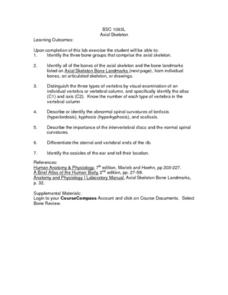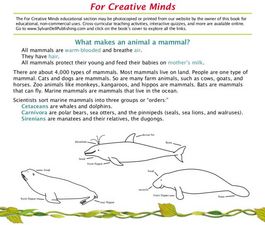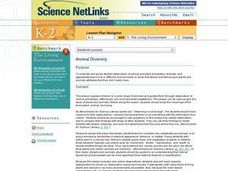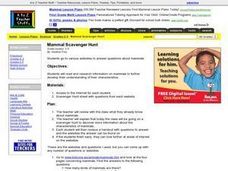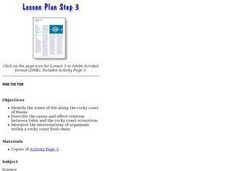Curated OER
Axial Skeleton and Fetal Skull
In this science worksheet, students identify bone groups from a given list. Students list each bone included in the axial skeleton. Students answer questions about specific bones, their location and importance.
Curated OER
Testing the Waters
Eleventh graders examine a local body of water. For this science lesson, 11th graders collect water samples to test. Students analyze the data and make conclusions. Students create tables and graphs of the data.
Curated OER
For Creative Minds: What Makes an Animal a Mammal?
Students read about categories of mammals and their features. Students then construct a marine animal, using given print outs in the lesson. Students then create adaptations for their mammal, using a web site reference for guidance.
Curated OER
Amphibians Crossword Puzzle
For this biology worksheet, students complete a crossword puzzle with 24 questions about different types of amphibians and functions of their body parts.
Curated OER
Utilizing Community Resources
Young scholars gain an understanding of scientific methods and use process skills (such as observing, classifying, and predicting) to solve a problem. They develop an understanding of the need for natural preservation.
Curated OER
A Limnology Study of Drainage Ditches
Students chemically test water, observe microscopic organisms in the classroom, and screen the sample for macroinvertebrates. They design a reporting sheet that list all the items to be tested and a space to record the results.
Curated OER
Animal Diversity
Students use the Animal Diversity E-Sheet to access the Where Can Animals Live? online book.
Curated OER
Classify That!
Students get acquainted with diverse forms of life by using modern biological classification systems to group animals that are related. They explore basic scientific groupings like genus, species, mammals, fish, birds, amphibians, and...
Curated OER
Fabulous Fossils
Seventh graders investigate how fossils are formed and discuss how scientists determine the appearance of ancient plants and animals. They make fossils of everyday objects for others to identify. They make spreadsheets to display fossil...
Curated OER
Mammal Scavenger Hunt
Students use the internet to answer their questions about mammals. They complete a scavenger hunt worksheet to identify their characteristics. They ask any questions they have at the end of the lesson.
Curated OER
Can You Find...on the "Progression of Life" Poster?
Students examine and analyze a poster that presents various types of animals throughout the ages. They determine biological classification with fossils and earth history in a game.
Curated OER
Birds Learning Cycle Lesson Plan
Ninth graders explore the various adaptations of birds and compare differences and similarities of different birds.
Curated OER
Mammal Anatomy Learning Cycle Lesson Plan
Ninth graders explore the anatomical and physiological structure of mammals and compare the different structures.
Curated OER
Mammals - Habitat/diversity Learning Cycle Lesson Plan
Ninth graders explore the characteristics and diversity of mammals, including key adaptations.
Curated OER
Classy
Students explore the classification system in this seven lessons unit. The diversity of life forms and their characteristics are examined using a microscope. Kingdoms, classes, and families are investigated.
Curated OER
Everything in Its Place: Science Classification
Students investigate the system of classification for living things through the sixteen lessons of this unit. The five kingdoms of monerans, protists, fungi, plants, and animals form the basis of several experiments as the similarities...
Curated OER
Animal Diversity
Students examine plants and animals for their similarties and differences. They are read stories and note how the animals in the stories do not have the qualities that real animals have. They complete a worksheet to end the instructional...
Curated OER
Protecting Against the West Nile Virus
Students anaylyze how the west nile virus is passed from mosquitoes to humans. They answer questions based on an article from the CDC. They finally examine their state map and track where cases have been reported.
Curated OER
Ride the Tide
Students examine the cause-and-effect relationship between tides and the rocky coast ecosystem. They complete a worksheet that illustrates the intertidal zone.
Curated OER
Animal Forms
Students demonstrate similarities and differences in animal forms, including humans.They investigate geometric relationships within those forms by building an animal using Zome System elements.
Curated OER
Paleontologist: Can You Dig It?
Students investigate what a paleontologist does. They participate in a dinosaur dig, write a story, and explore the Dinosaur Dig website to view and discuss photos of a real dinosaur dig.
Curated OER
Coqui Frog Camouflage
Students investigate the concept of the coqui frog of Puerto Rico. They conduct research using a variety of resources. Students explain in oral or written form some of the characteristics to that identify the frog. The lesson includes...
Curated OER
Creature Features
Students examine why certain animals live in only specific places throughout the world. Using animals, they classify them based on their characteristics and identify their basic needs. They also observe and compare the life cycles of...
Other popular searches
- Invertebrates and Vertebrates
- Life Science Vertebrates
- Five Classes of Vertebrates
- Invertebrates Vertebrates
- Vertebrates an Invertebrates
- Characteristics of Vertebrates
- Invertebrates + Vertebrates
- Biology and Vertebrates
- Vertebrates Lesson Plans
- Classify Vertebrates
- Vertebrates Lesson
- Animal Families Vertebrates


